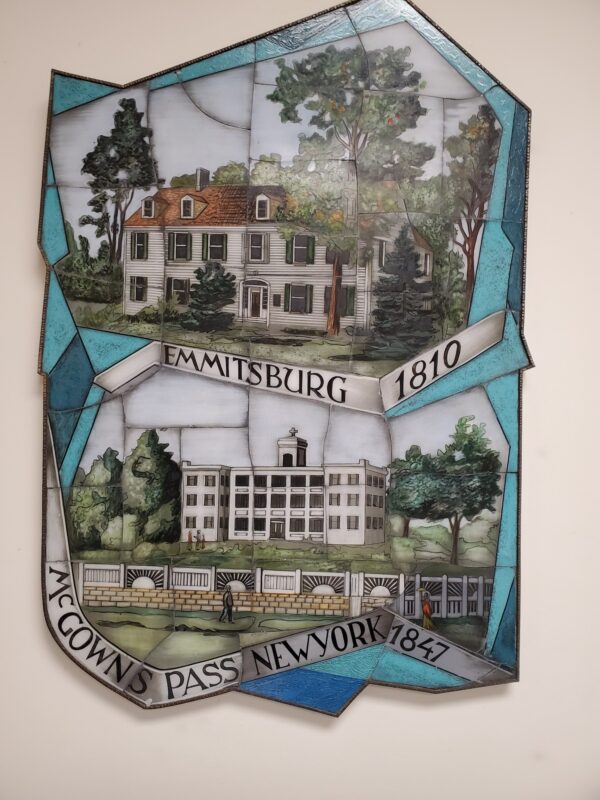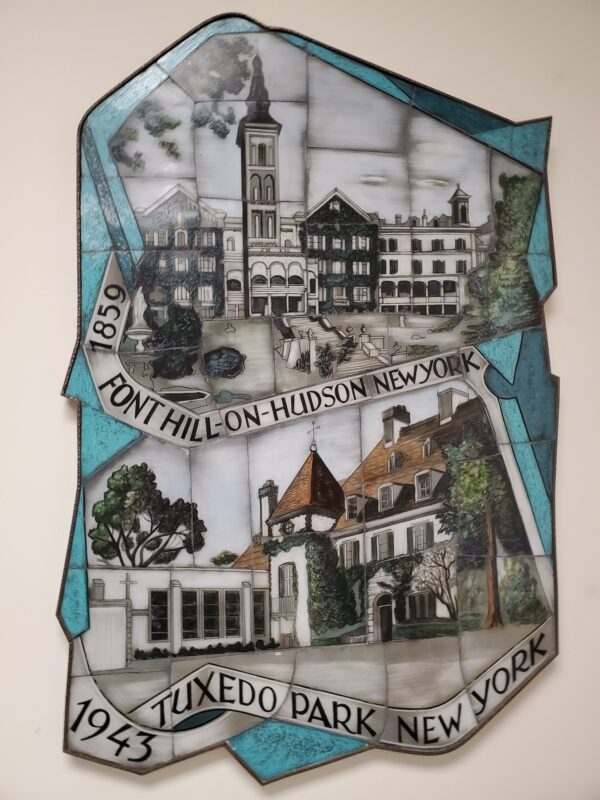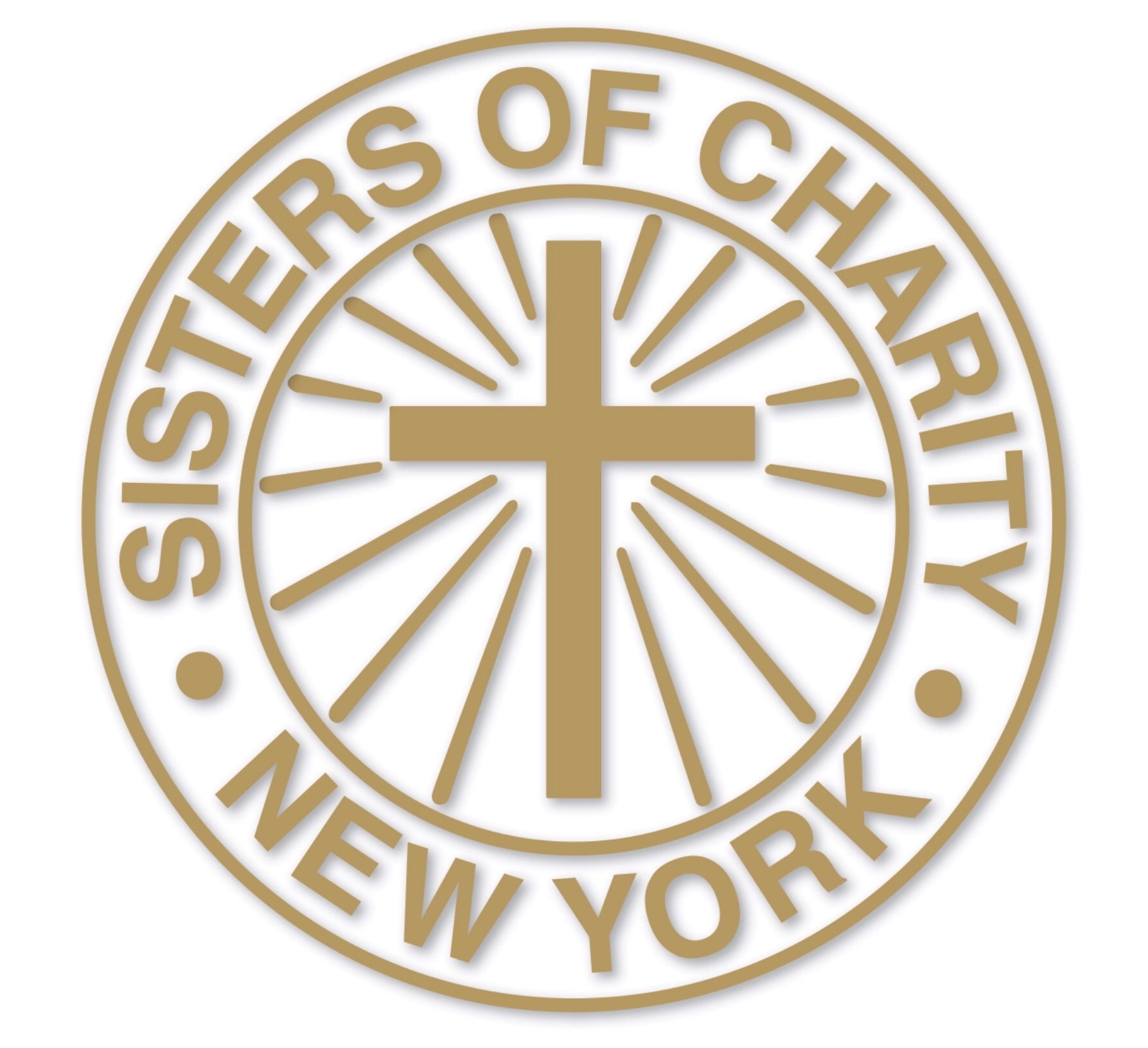A History of the Sisters of Charity of New York in Objects
by Mindy Gordon, Director, Archives and Museum
This article is the first in a series, ‘A History of the Sisters of Charity of New York in Objects,’ to feature artifacts from the Archive, which highlight aspects of the distinguished history of the New York Community.
The Archives at the Sisters of Charity of New York house a rich collection of artifacts, each reflecting an important part of the history of the Community that began in New York City in 1847. Furniture, artwork, sculpture, textiles, prayer books and ephemera, and items that belonged to the early Mothers of the Congregation, all are individually worthy of a descriptive narrative.
Two stained-glass panels displayed at the Archives at Mount Saint Vincent, Bronx, N.Y., portray the buildings that were Saint Joseph’s Free School and The Academy of Mount Saint Vincent, two of the oldest Catholic academies for girls in the country.
The panels have been displayed since 1982 at Elizabeth Boyle Hall, the renovated landmark carriage house and location of the archives of the Sisters of Charity of New York. The colorful stained-glass panels are unique, each depicting two buildings; one in an upper panel and one in a lower panel. Irregularly shaped, each piece measures 35” high at its highest point, and 24” width at its widest point.

Panel 1, upper section: Emmitsburg, Maryland, 1810:
While living in Baltimore, Elizabeth Ann Seton expressed a desire to “assist the poor… clothe little innocents and teach them to love God.”* Fortunately, a wealthy congregant and convert, Samuel Sutherland Cooper, agreed to contribute to this effort. Subsequently, Mr. Cooper purchased a property in the valley near Saint Joseph’s Church in Emmitsburg as home for the proposed new religious community and school.
Several months after Elizabeth Seton arrived in Emmitsburg, Maryland, the new community of the Sisters of Charity of Saint Joseph’s opened a free school, the two-story Federal-style building depicted, today known as the ‘White House.’ On February 22, 1810, three girls were the first day students to attend Saint Joseph’s Free School, the first free Catholic school for girls staffed by religious women in the country. To accommodate the day students of limited means from the village, a tuition of $100 annually was required for boarding students to satisfy expenses.
Many years later, Saint Joseph’s Academy and Free School became Saint Joseph’s High School, 1890-1946, and later became Saint Joseph’s College, a four-year liberal arts college for women, opened in 1902 and closed in 1973.
Panel 1, lower section: McGown’s Pass, Manhattan, 1847:
Mother Seton’s school in Emmitsburg was the precursor to the Academy of Mount Saint Vincent, Bronx, opened after the New York Sisters separated from the Emmitsburg community in 1847. Under the patronage of Reverend John Hughes, the first Archbishop of New York and brother to Mother Mary Angela Hughes who led the Community 1855-1861, the Academy at McGown’s Pass was regarded as one of the pioneer institutions in the East for the education of Catholic girls. In 1851, the Academy received its charter from the New York State Legislature. McGown’s Pass at approximately 109 Street and Fifth Avenue, had been the location of Revolutionary War headquarters for George Washington and his army.

Panel 2, upper section: Font Hill-On-Hudson, Bronx, New York, 1859
When the Sisters were asked to vacate the McGown’s Pass property in Manhattan for the planned development of Central Park, they purchased the 55-acre estate Font Hill-On-Hudson from renowned Shakespearean actor Edwin Forrest. Located on the east bank of the Hudson River, the property included three buildings: the Gothic style ‘castle’ that initially housed the school’s library, dining hall and drawing room; the Villa, used as a residence for clergy, and the carriage house and stable, now Elizabeth Boyle Hall and the archives.
In 1859 when construction of the first building at Font Hill-on-Hudson was completed, the building included accommodations for the new Academy and boarding students. The classrooms, grand study hall, art room, music hall, reception rooms, as well as the Convent and Chapel of the Immaculate Conception were housed in this building, today known as Founders Hall. The building included a grand entrance and a balcony of 500 hundred feet used for leisure time for Sisters and students.
In 1910, as an outgrowth of a ‘fifth year’ year of study offered by the Academy, the school received a charter from the State Education Department of New York to recognize ‘The College of Mount Saint Vincent.’ Soon thereafter, construction of collegiate buildings began.
Panel 2, lower section: Tuxedo Park, New York, 1943
As the College student population increased, the need for separate quarters for the Academy’s faculty, students, and activities, was addressed. To provide a new location for the school, Archbishop Spellman deeded an estate in Tuxedo Park, New York, that had been donated to the Archdiocese of New York by Mrs. E. John Heidseick. On this property, the mansion ‘Chastellux’ first housed the Academy of Mount Saint Vincent at Tuxedo Park in 1943. In 1947, the Academy expanded in acreage when Mr. Erasmus Lindley deeded his adjacent home and property.
A handwritten note recorded by Sr. Maria Lawrence Keating, who taught at the Academy of Mount Saint Vincent, Tuxedo Park, from 1948-1966, states that Mother Mary Fuller asked artist Peter Appleton, who designed the windows for the Tuxedo Park chapel to create these plaques to honor the tradition of the Academy.
Alumnae of the Academy of Mount Saint Vincent
For 30 years, the Academy thrived in this location until a decline in enrollment led to the closure of the school in 1972. The estate buildings and grounds are now privately held. The Alumnae of the Academy of Mount Saint Vincent are a vibrant group of women who gather annually at the Tuxedo Club in Tuxedo Park, N.Y. They maintain a strong connection to and continue to support the mission of the Sisters of Charity of New York.

I enjoyed reading this article.